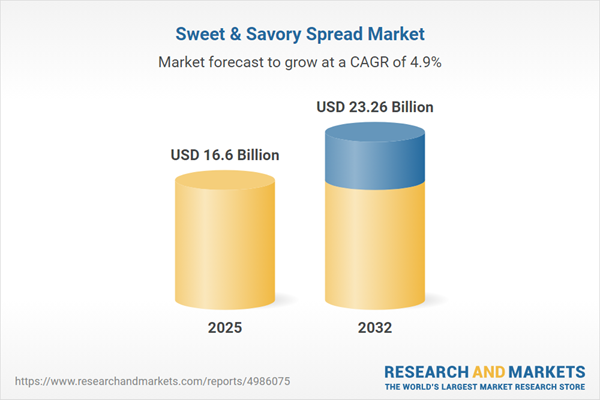Speak directly to the analyst to clarify any post sales queries you may have.
The sweet and savory spread market is undergoing rapid evolution as manufacturers respond to new consumer demands, sustainability pressures, and innovations in packaging. For senior decision-makers, this landscape requires a balance of clear strategic focus and operational agility to stay ahead and seize emerging opportunities.
Market Snapshot: Sweet and Savory Spread Market Growth
Sustained global demand is fueling the expansion of the sweet and savory spread market across established and developing economies. Brands are leveraging inventive product flavors and adaptable packaging formats to stand out in a competitive segment. Leaders and nimble new entrants are rolling out products at an accelerated pace, responding flexibly to changing market preferences. Successful differentiation now hinges on real-time consumer insight and faster product innovation cycles. Retail and foodservice operators are updating their product assortments and supply processes, emphasizing the necessity for swift adaptability and robust market responsiveness as the landscape becomes more dynamic.
Scope & Segmentation
- Product Types: Cheese-based spreads, pâtés, vegetable varieties, chocolate-based options, preserves, honey, and nut butters support direct consumption, meal customization, and fulfill unique foodservice requirements.
- Packaging Types: Bottles, jars, pouches, and tubes all weigh differently on logistics, brand identity, and consumer convenient usage in varied global markets.
- Packaging Sizes: Single-serve, mid-size, family, and bulk formats meet the needs of households, retailers, and institutional food service, aligning with different consumption and supply preferences.
- Price Tiers: Economy, mid-range, and premium bands enable brands to approach a wider audience or focus on targeted niches as strategy requires.
- Distribution Channels: Convenience stores, online platforms, specialty retailers, supermarkets, and hypermarkets all offer pathways to reach increasingly diverse buyer cohorts through omnichannel strategies.
- Applications: Options for direct eating, cooking, dipping, baking, and meal preparation allow versatile use among households, hospitality, and business clients.
- End Users: Institutional buyers value reliable supply and product consistency, while end consumers prioritize variety, ease, and regular category innovation.
- Geographic Coverage: The Americas, Europe, Middle East, Africa, and Asia-Pacific are major market regions. Countries such as China, India, Japan, Australia, and the nations of Southeast Asia present significant growth opportunities. Strategic adaptation to local contexts helps unlock regional performance.
- Notable Companies: Leading and influential brands include La Casa, The J. M. Smucker Company, The Kraft Heinz Company, Conagra Brands, B&G Foods, Nestlé, Hartley, My Savory Store, and Ferrero U.S.A.
Key Takeaways for Senior Decision-Makers
- Introducing clean-label, plant-based, and functional spreads aligns offerings with the increasing expectations of health-conscious consumers and amplifies brand reputation.
- Advanced packaging innovation, including sustainable and consumer-friendly solutions, enables quicker adaptation to local retail trends and evolving shopper behaviors.
- Strategic focus on ethically sourced raw materials and recyclable packaging strengthens compliance credentials and enhances customer loyalty as sustainability grows in priority.
- Adopting direct-to-consumer and digital channel strategies facilitates timely market insights and enhances the ability to fine-tune offerings based on real-world consumer feedback.
- Customizing marketing and supply strategies for specific regions supports stronger market entry and more agile responses to shifting regulations and buyer expectations.
- Investing in resilient supply chains and exploring flexible co-manufacturing relationships helps sustain operational continuity during demand fluctuations or global disruptions.
Tariff Impact and Strategic Response
The introduction of recent U.S. tariffs has prompted market participants to broaden their supplier bases and deepen collaborations with regional supply partners. These measures safeguard against policy-driven disruptions and reinforce the agility and strength of operational capabilities as regulatory and trade environments shift.
Methodology & Data Sources
This analysis brings together insights from executive interviews, direct consumer panel engagement, and the review of multi-channel sales data. Advanced segmentation methods, predictive analytics, and regulatory compliance assessments support the objective and action-oriented findings presented for the sweet and savory spread market.
Why This Report Matters
- Empowers executives with practical tools to build robust risk mitigation strategies and shape agile, sustainable plans in a fast-changing sector.
- Supplies valuable market intelligence to maintain supply chain reliability and ensure sourcing remains stable even amid regulatory shifts or periods of market uncertainty.
- Equips decision-makers to accelerate product innovation and align launches efficiently with current demand across multiple sales channels.
Conclusion
Effective, data-driven management will position organizations to adapt quickly and consistently realize new opportunities. Using insights from this report, senior leaders can anticipate market shifts and drive sustained competitive growth.
Additional Product Information:
- Purchase of this report includes 1 year online access with quarterly updates.
- This report can be updated on request. Please contact our Customer Experience team using the Ask a Question widget on our website.
Table of Contents
3. Executive Summary
4. Market Overview
7. Cumulative Impact of Artificial Intelligence 2025
Companies Mentioned
The companies profiled in this Sweet & Savory Spread market report include:- La Casa
- The J. M. Smucker Company
- The Kraft Heinz Company
- Conagra Brands, Inc.
- B&G Foods, Inc.
- Nestlé S.A.
- Hartley
- My Savory Store
- Ferrero U.S.A., Inc.
- The J. M. Smucker Company
Table Information
| Report Attribute | Details |
|---|---|
| No. of Pages | 182 |
| Published | October 2025 |
| Forecast Period | 2025 - 2032 |
| Estimated Market Value ( USD | $ 16.6 Billion |
| Forecasted Market Value ( USD | $ 23.26 Billion |
| Compound Annual Growth Rate | 4.9% |
| Regions Covered | Global |
| No. of Companies Mentioned | 11 |









